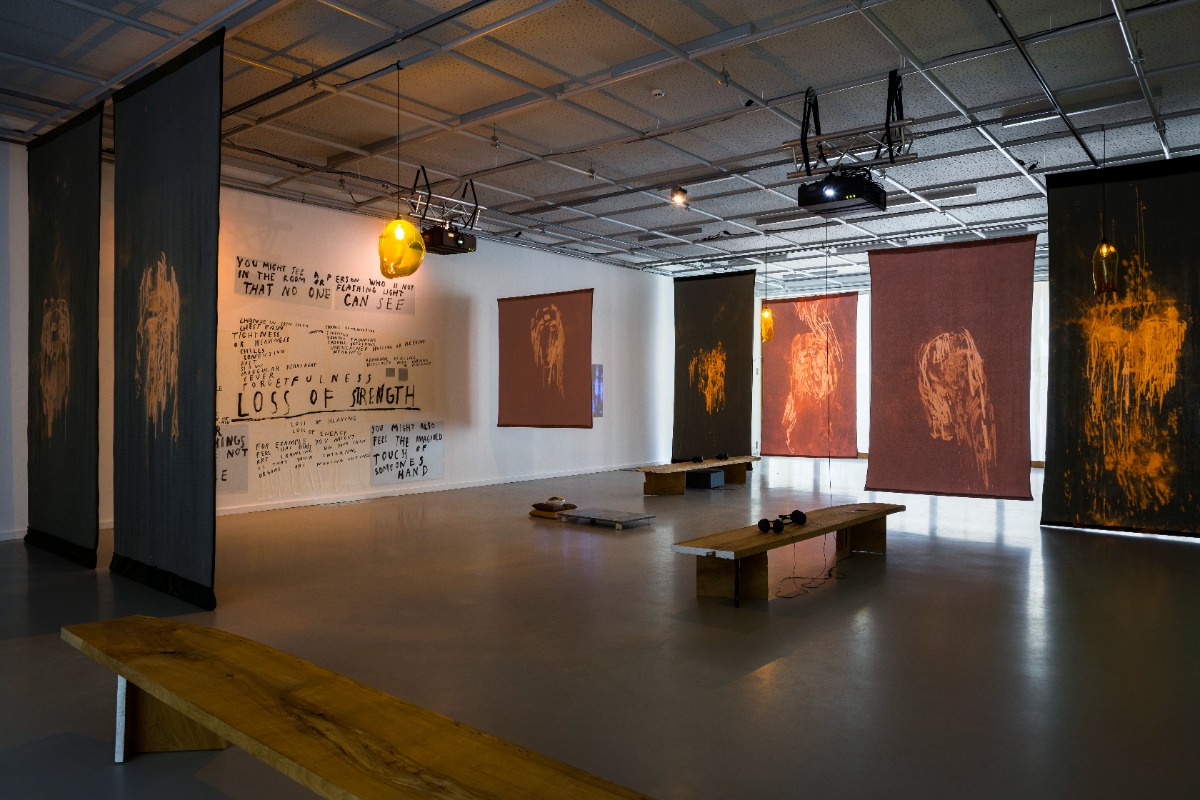
I spent many hours in the forest
An interview with Rado Ištok, curator of The Spectral Forest at Nida Art Colony (NAC)
The international group exhibition The Spectral Forest, curated by Stockholm-based Rado Ištok, is on view at the Nida Art Colony (NAC) of the Vilnius Academy of Arts through 8 November. Ištok has brought together eight artists (Eglė Budvytytė, Susanna Jablonski, Paul Maheke, Elin Már Øyen Vister, Santiago Mostyn, Ieva Rojūtė, Mark Ther, and Jin Mustafa) that explore a spectrum of histories, ecologies, and mythologies intertwined with both local and planetary woodlands. The Spectral Forest presents newly commissioned and existing works as a promenade through an enchanted forest – a concept based on the significance of the sacred groves in the Baltic region – as well as informs the viewer on current deforestation and afforestation and past displacement and resettlement on the Curonian Spit. Referring not only to spectres, ghosts, and spirits traditionally residing in the forest but also to the notion of the spectrum as a condition that is not limited to a specific set of values, the exhibition poses continuity, fluidity, and permeability against the reductive binaries and divisive language increasingly dominating the political climate.
What is the main message behind the exhibition The Spectral Forest? How did the idea for the show come about and what prompted it?
The exhibition The Spectral Forest presents newly commissioned and existing works by eight international contemporary artists. Five of the artists – Eglė Budvytytė, Paul Maheke, Jin Mustafa, Mark Ther, and Elin Már Øyen Vister – were invited to spend two months at NAC last autumn in order to produce new works for the exhibition. Ieva Rojūtė was invited to spend one month at NAC before the exhibition (also to produce a new work), and she also became the exhibition designer.
The residencies of Susanna Jablonski and Santiago Mostyn had to be postponed due to the outbreak of the pandemic, so instead of a joint new commission, we agreed to include their existing works. Considering that the exhibition heavily relied on newly commissioned works, my role as a curator in this case was to give each of the artists the freedom to produce any work they wanted to, to closely follow the process, and to look for links between the new works and embed them in a coherent but not too restrictive framework, which ultimately became The Spectral Forest.
I was also interested in mediating a dialogue between the newly commissioned works and the history and landscape of the Curonian Spit, where NAC is located. Besides the spectacular sand dunes, the Curonian Spit has a long history of deforestation and afforestation, as well as displacement and resettlement connected to WWII and its aftermath. During my research, I also became interested in the significance of sacred groves in the Baltic region. The natural world, unfamiliar to our ancestors with its seemingly inexplicable phenomena, was often perceived as another world on earth – the realm of mythological creatures and the supernatural. In many folk narratives both in Lithuania and around the world, a forest – a sacred grove in particular – contains a pathway to other worlds. For the Curonians, a Baltic tribe that came to the Curonian Spit from what is now Latvia, the sacred groves were closely associated with the cult of the dead. Today, the nearby border checkpoint between Lithuania and the Kaliningrad Region – an aperture in the political border dividing the Curonian Spit in half – can also be seen as a pathway to another world.
Installation view The Spectral Forest at NAC of Vilnius Academy of Arts within the framework of 4Cs. Photo: Ansis Starks
The exhibition was thus conceived as a promenade through an enchanted forest, a living organism inhabited not only by wildlife, but also hybrid creatures and ghosts – spectres – of the unresolved past. The Spectral Forest refers to these spectres and spirits traditionally residing in the forest, but also to a spectrum. Both words have the same Latin root (spectrum: appearance, apparition), but spectrum represents a band of colours, as seen in a rainbow, or more generally a condition that is not limited to a specific set of values as quantifiable numbers but that can vary across a continuum. The continuous spectrum then stands for a range that changes gradually. I believe it can be a useful tool when thinking beyond the binaries of two extreme positions, e.g. in relation to the fluidity of gender and national identities, mental health, or the political spectrum rather than two opposing camps. This also became a way for me to think about conflict and conviviality, as the exhibition is part of the project 4Cs: From Conflict to Conviviality through Creativity and Culture, co-funded by the Creative Europe Programme of the EU and the Lithuanian Council for Culture. Like a forest which encompasses various species, a spectrum implies a broad range grouped together. Similarly to the Curonian Spit National Park, The Spectral Forest is understood as a sanctuary in which different voices complement and enhance each other, even if sometimes seemingly in a cacophony.
Paul Maheke, We took a sip from the devil’s cup, 2020. Bleach on fabric, hand blown glass. Courtesy of the artist and Galerie Sultana, Paris. Commissioned for The Spectral Forest, NAC of Vilnius Academy of Arts within the framework of 4Cs. Photo: Ansis Starks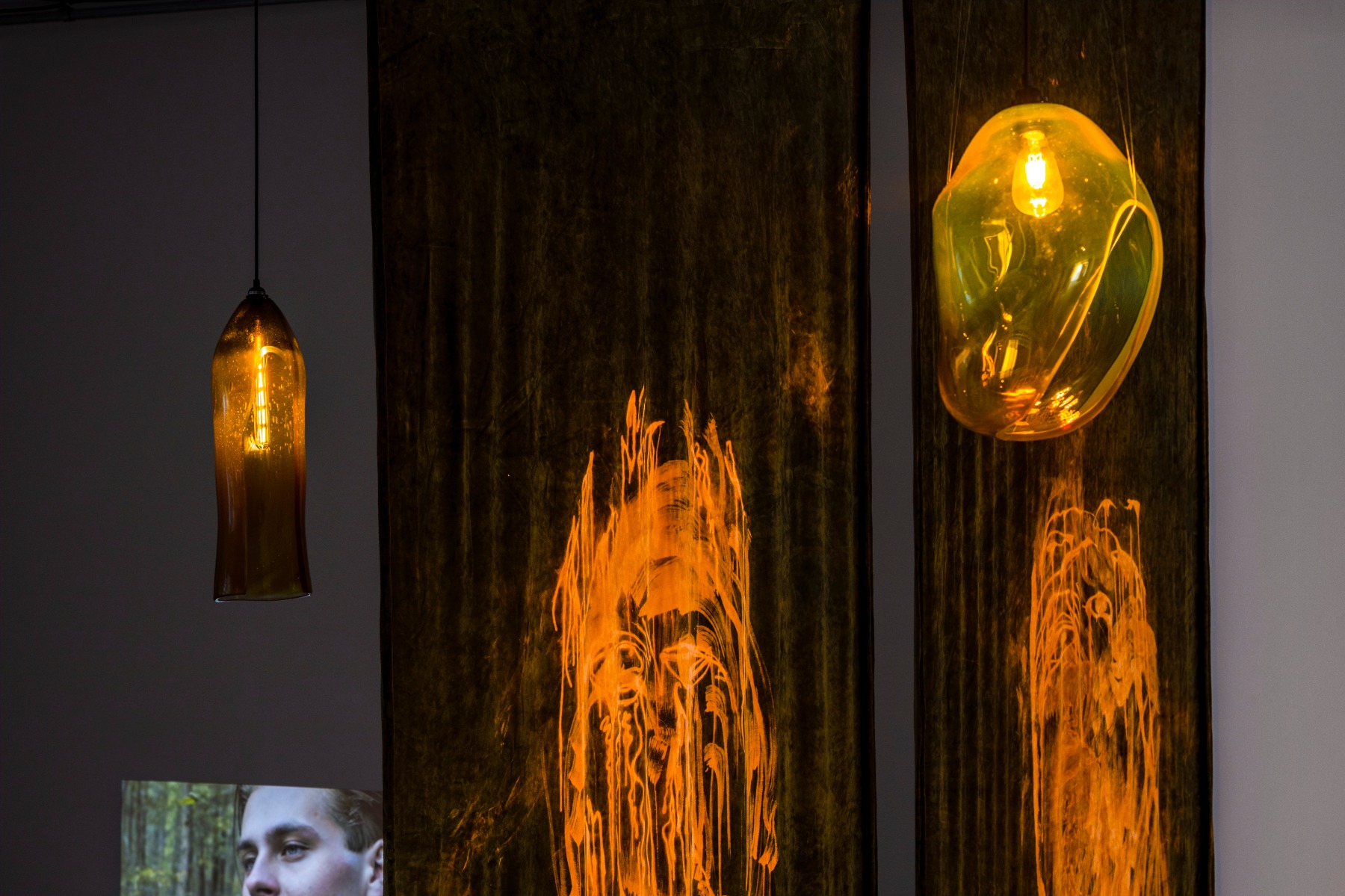
The forest has become one of the most central themes in terms of stories from the 21st century. In some way, the forest has become a symbol in the global battle over climate issues. Does art have the capacity to help forests survive, and is the involvement of art in such global processes meaningful?
While I believe in the role of art in society and its potential to give visibility to urgent issues, including climate change, the works in the exhibition address a different set of questions. For example, Eglė Budvytytė’s new film Songs from the Compost: Mutating Bodies, Imploding Stars (2020), made in collaboration with Marija Olšauskaitė and Julija Steponaitytė and co-commissioned by RIBOCA, explores the darker aspects of symbiotic life in the forest: interdependence, death, decay, and decomposition as a way to imagine the world outside of linear time. The films draw on the ideas of the biologist Lynn Margulis, which celebrate the role of bacteria in making life possible and the collaboration between single-celled organisms, as well as on the ideas of science-fiction author Octavia Butler, who employed tropes of symbiosis, mutation, and hybridity to challenge sociobiological causes of hierarchical violence. While the film and the lyrics of its song address the imbalance between the human and the non-human, it is not a film about the climate crisis per se.
In comparison, Santiago Mostyn’s film Drawing for Bellevue Estate (2018) is conceived as a portrait of Tobago as a non-human yet sentient being, subject to past and present exploitation of the island’s resources, the labour of its inhabitants, and its tropical imagery. Tobago was successively colonised by various European powers, including the Duchy of Courland in the 17th century when the duchy was a vassal state of the Polish-Lithuanian Commonwealth, and in the 18th century the island inspired the setting for Daniel Defoe’s novel Robinson Crusoe. It thus played a crucial role in the development of the tropical imaginary, with its lush vegetation and diversity of species. Footage of men making measurements and cutting the vegetation to mark territory alternates with footage of a sacred silk cotton tree connected to the African ‘witch’ and spiritual healer Gang Gang Sarah, who is believed to have attempted – but failed – to fly back home to West Africa from this tree. Her story speaks of the literal and metaphorical impossibility of return for all exiled peoples, including the people displaced from the Curonian Spit at the end of WWII. There are subtle links between deforestation and displacement, as well as between rooting and belonging.
Installation view The Spectral Forest. Video: Santiago Mostyn, Drawing for Bellevue Estate, 2018. 16mm to 2K transfer, stereo sound, colour/black & white, 12’00”. Courtesy of the artist. Photo: Ansis Starks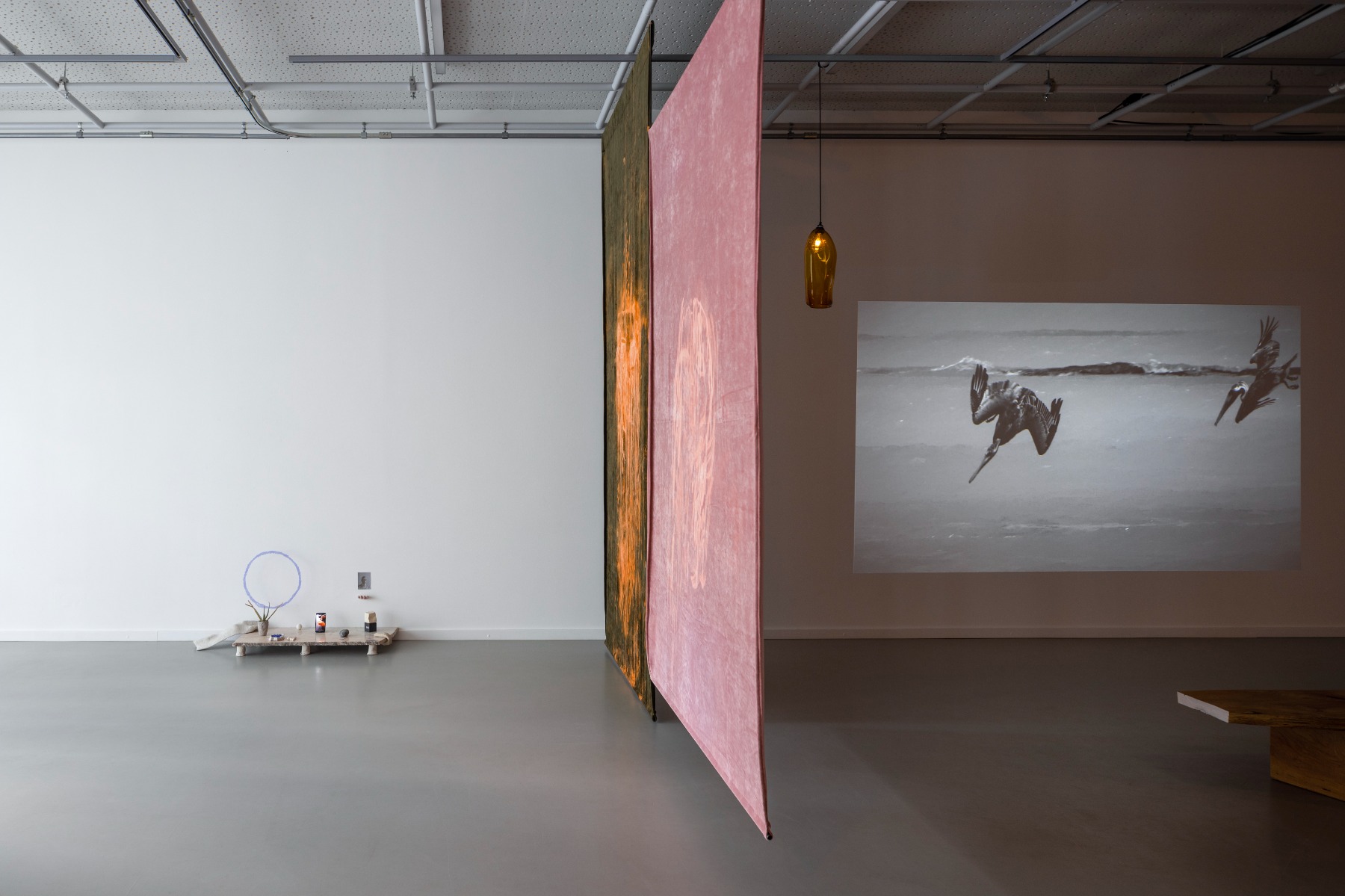
Could you say little bit more about the meaning of the spectres in the exhibition?
The first of the works newly commissioned for the exhibition that I saw was a series of seven monumental drawings bleached into fabric – We took a sip from the devil’s cup (2020), by Paul Maheke. The otherworldly faces in the drawings are loosely based on a tasseography session, a divinatory reading of patterns in coffee sediment, that we did together during the residency. They reflect Paul’s long-term interest in the esoteric and its relationship to non-Western forms of knowledge production. For Paul, ghosts and other non-human messenger figures carry narratives that often address questions of erasure and permeability in the construction of identity. At the same time, the fabric’s vertical format, colour palette, and placement forming a route through the gallery also reminded me of Lithuanian folk tales in which a pathway to other worlds often leads through a forest, as I mentioned earlier. In such tales one often encounters souls of the dead trapped in trees, as if in purgatory, or supernatural beings evoking awe and respect towards nature and sacred sites. The devilish faces bleached into the fabric thus became one of the defining elements of the exhibition, enhanced by the amber-like glass lamps hand-blown by Atelier Gamil in France.
Paul Maheke, We took a sip from the devil’s cup, 2020. Bleach on fabric, hand blown glass. Courtesy of the artist and Galerie Sultana, Paris. Commissioned for The Spectral Forest, NAC of Vilnius Academy of Arts within the framework of 4Cs. Photo : Ansis Starks
Spectres are, however, present in different forms in many of the works in the exhibition. For example, for Jin Mustafa, sound is not only heard but also felt, creating a particular sensation and a feeling of anticipation, because sound is often a warning sign betraying a presence of someone or something, especially in darkness when our vision is obscured. In her newly commissioned film Ahead of Sight (2020), images and sounds are intertwined with a poetic dialogue of voices which communicate across time and space, communing through a technological – or quite possibly a mystical – shortcut. In fact, sound technology as a medium has from its early beginnings been connected to the double meaning of medium as a technological means of conveying a message and a psychic communication with the spirits of the dead or the realm of the supernatural. While sound technologies today provide us with unforeseen possibilities, they are also ever more susceptible to surveillance. Even without having been recorded, frequencies of sound and spoken words reverberate eternally and can potentially be retrieved as ghosts of the past by future technologies.
Video on the left: Eglė Budvytytė with Marija Olšauskaitė and Julija Steponaitytė, Songs from the Compost: Mutating Bodies, Imploding Stars, 2020. HD video, 29 min. Courtesy of the artist. Commissioned for The Spectral Forest, NAC of Vilnius Academy of Arts within the framework of 4Cs and 2nd Riga International Biennial of Contemporary Art, RIBOCA2. Photo: Ansis Starks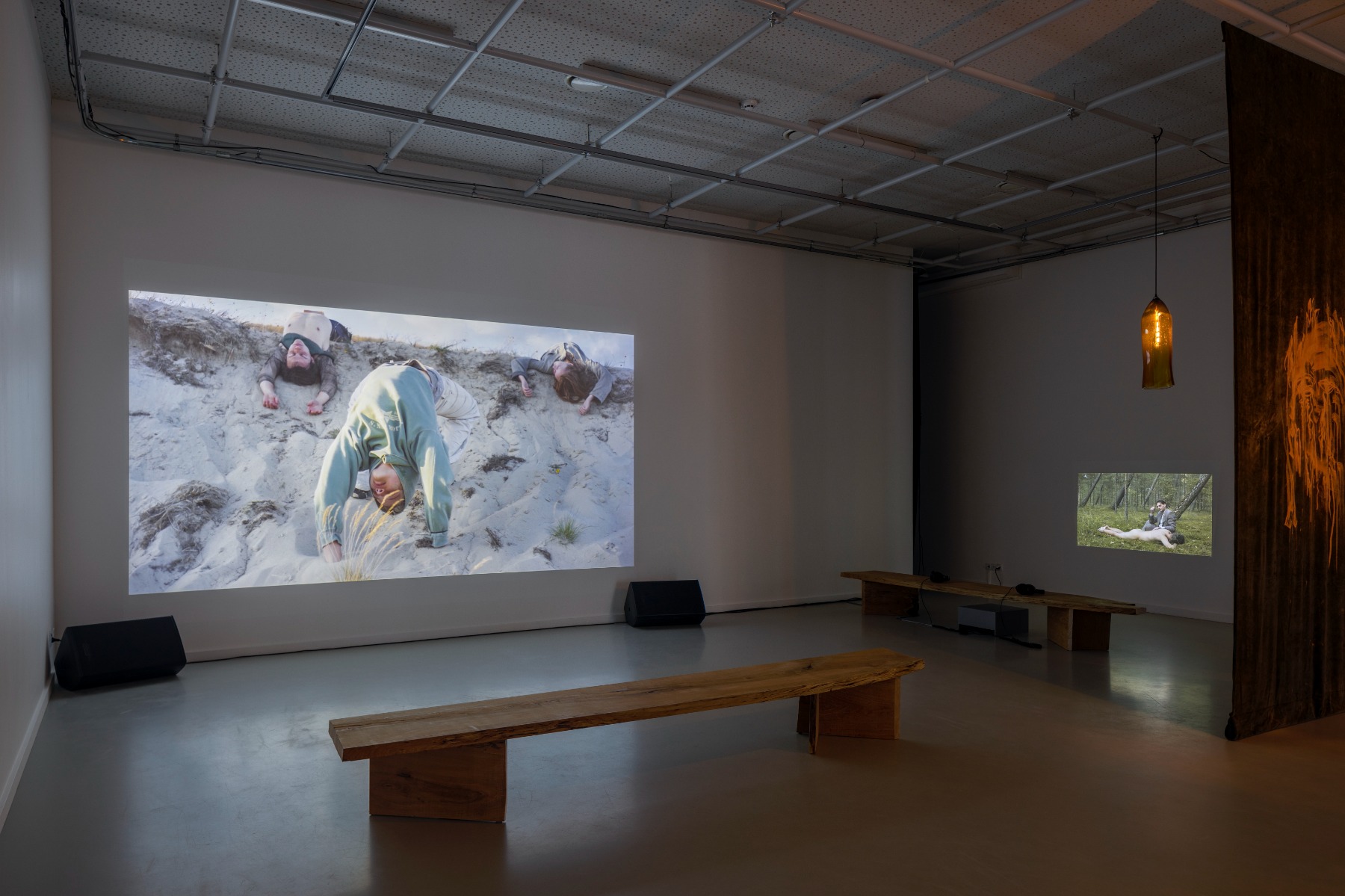
We’re losing our connection with nature and a knowledge of nature that has been passed from generation to generation over centuries; we have lost our sense of empathy toward nature. Is this pandemic a kind of punishment for our hubris?
I think it would be hubris to think that the pandemic is a punishment for humans because that would, again, place humans at the centre. The fact that the pandemic has had the most devastating impact on the most vulnerable in society suddenly laid bare the inequalities that were already in place: Who has the opportunity to work from home? Who has access to free healthcare? For whom is home a safe space, and for whom is it a space of violence? And so on. And I don’t think that those who are being ‘punished’ most severely are those to be blamed for where we are as humanity in relation to nature and our planet.
When it comes to a connection with nature and a knowledge of nature that has been passed from generation to generation, this is something that Elin Már Øyen Vister explores in her work. Inspired by the work of Lithuanian-American archaeologist and anthropologist Marija Gimbutas and her research on the matrilineal structures of pre-Christian Baltic societies, Elin’s work, Offerings to the voices of the wind, the sea and the land (2020), consists of two ceramic vessels created in collaboration with the ceramicists Cecile Haaland (based in Lofoten, Norway) and Robertas Simatis (based in Juodkrantė, Lithuania), as well as a sound composition which weaves together field recordings with Norwegian, Sámi, and Lithuanian folk music. It tells the stories of the people, animals, plants, land, and sea, such as the story of Neringa, a friendly giantess who, according to legend, created the Curonian Spit, and thus also the lagoon, to protect the fishermen from the Baltic Sea. For the workshop Dwelling on the Treshold, which took place at NAC last autumn, Elin, who is also a forager, led a walk in which the participants were introduced to some of the local plants and their medicinal benefits. After returning from the walk, Elin prepared herbal teas from some of the local herbs and plants, attempting to reconnect with this knowledge that has in many places been swept away by modernisation and is currently being capitalised on by Western pharmaceutical companies.
In the front: Susanna Jablonski, Henry’s Couch, 2019. Marble, paper clay, wasp nest, ceramic, textile. Courtesy of the artist. Photo: Ansis Starks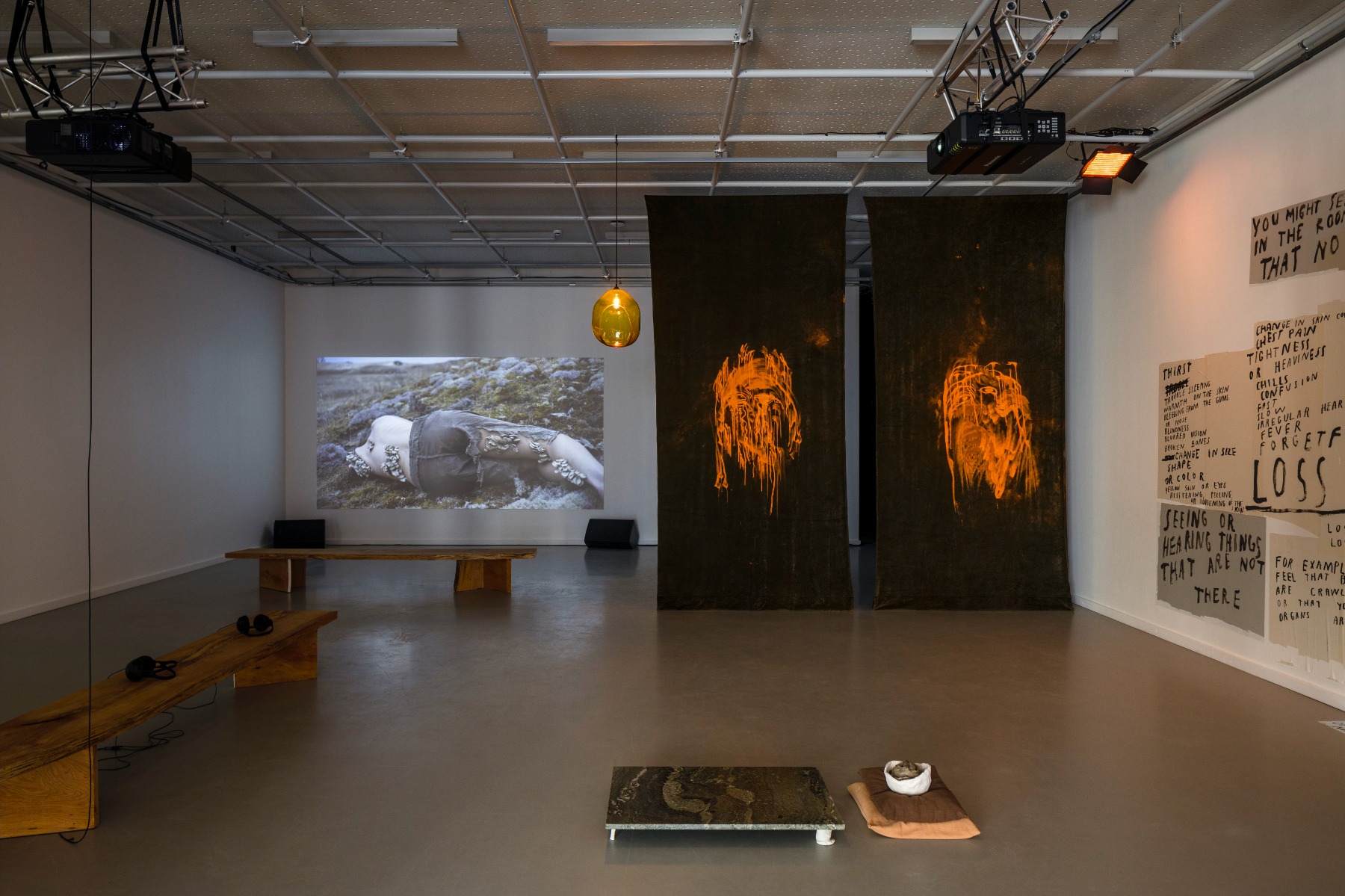
Medication and healing are also the subject of two works by Ieva Rojūtė. First, Ieva covered the windows of the gallery with a translucent milky filter, evoking the comfort of being under a white blanket. She associates this feeling with her childhood inhalation sessions when, with her head under the blanket, she would inhale the steam evaporating from hot salted water as a treatment for her bronchitis. In psychology, items providing comfort in stressful situations are known as comfort or transitional objects, but also as security blankets. Second, Ieva’s textual work is based on the experience of reading medication package inserts. The drugs’ potential side effects become a source of worrisome scenarios, highlighting the links between the pharmaceutical products and pharmakon, a philosophical concept with a triple meaning: remedy, poison, and scapegoat – a person excluded from a community in times of crisis. Ghostly side effects – such as seeing or hearing things that are not present, confusion and blurred vision, unexplained bruising or bleeding, unusual tiredness or weakness – are reminiscent of folk tales of demons visiting people in their sleep.
Invisible ties bind humans to the plant world. There is an exercise in Qigong in which you imagine that you are a tree and you have to decide upon a tree species. What kind of tree are you – pine, oak, willow...? Can you associate yourself with a tree species?
I recently saw the exhibition There’s No Such Thing as Solid Ground by Otobong Nkanga at Gropius Bau in Berlin. In the first gallery there is an installation with rootless plants that thrive by absorbing water and nutrients through the air and their leaves – which points to displacement and survival for those who are denied the possibility of taking root. For many people who underwent the process of migration, whether as forced displacement or willingly – like myself, it can be hard to imagine themselves as a tree. I am thinking of something I recently read about the world’s largest living organism: a fungus that covers over 2,000 acres in a national park in Oregon. Most of it is underground, an extensive network of roots called mycelia; the mushrooms which show up above ground are just a very small part of the organism. I think that’s how I feel about myself. I am not rooted in one place, but neither am I completely living off of air. Instead I rely on a large support network of friends and collaborators located in places where I have lived in the past or elsewhere, but who are important in my life and whom I often visit, appearing like a mushroom after rain. When I think of it now, perhaps Eglė Budvytytė’s workshop The Pleasure of Being Dragged last autumn helped me to somewhat change my perspective from the verticality of humans and trees in favour of horizontality, such as in mycelia; in fact, mushrooms also appear in Eglė’s new film.
Thinking of the plant kingdom, there is actually a living plant in the exhibition too. Susanna Jablonski’s sculptural installation Adrianna’s Akato (2019) includes a Venezuelan aloe vera plant. Standing on the threshold of the exhibition, Adrianna’s Akato is a metaphorical bedside table imagined as a monument to the experience of the artist’s friend, a Venezuelan filmmaker currently exiled in Barcelona. In the spiritual beliefs of the Ye’kuana people of Venezuela, akatos are one’s six spirit counterparts, invisible and eternal. Some travel away from the body at night, but if an akato cannot find its way back to its human entity, for example due to involuntary migration, there can be serious consequences, including deteriorating physical and mental health and possibly even death. In Susanna’s other sculptural work, Henry’s Couch (2019), there is a wasp nest in a ceramic form, cradled by a pair of pillows. While it can be seen as an open head on the psychoanalyst’s couch – a container for buzzing thoughts, emotions, and memories – the nest can also be seen as a symbol of home, although it’s hanging in the air rather than growing from the ground as one usually imagines a home.
Susanna Jablonski, Adrianna's Akato, 2019. Marble, paper clay, glass, ceramic, video, various materials. Courtesy of the artist. Installation view The Spectral Forest at NAC of Vilnius Academy of Arts. Photo: Ansis Starks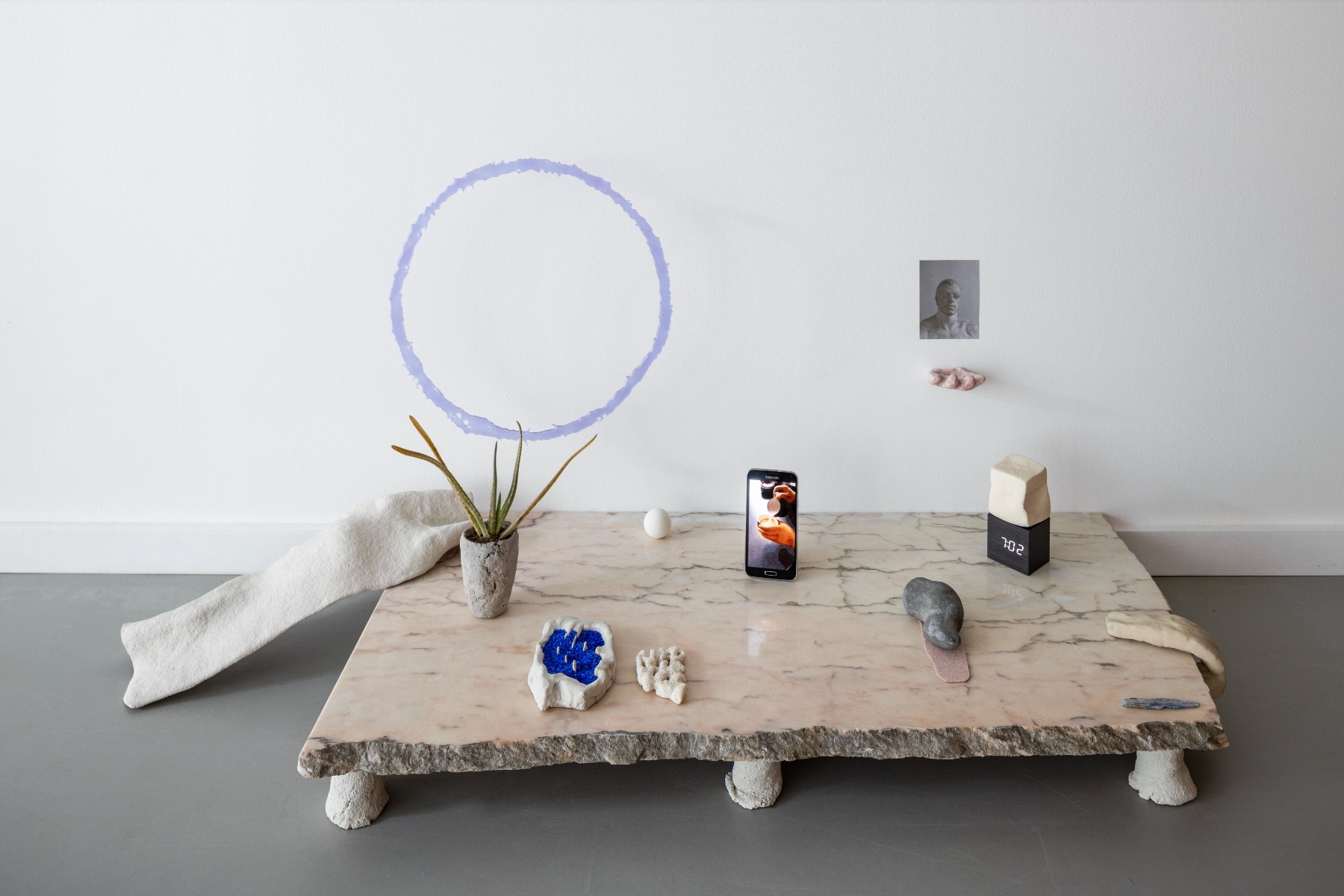
Baudelaire says in The Flowers of Evil that the world is a forest of symbols. How many hours have you spent in the forest while working on this exhibition? Could you say that you understand the forest and it’s needs, it’s symbolic language of sounds, smells, colours, plants, animals and non-animals?
Due to the pandemic in particular, I spent many hours in the forest this spring and summer. There is a large nature reserve with forests and lakes just a few minutes away from my house, and although I have been there many times before, the outbreak of the pandemic slowed down my life, including travels. Therefore I decided, as many other people during this time, to better explore my immediate surroundings. Walking is very important for my thinking, and walking in a place regularly makes you more attentive to details and even minor changes. I wouldn’t dare to say that I understand the forest and it’s needs, but thinking of Baudelaire, it felt good to become a flâneur in the forest, if that’s even possible. While in Nida last autumn and this summer, I tried to take morning and/or late-afternoon walks in the forest, the dunes, or on the beach every day; it became an internal part of my days there.
Linking to the decadence and eroticism of The Flowers of Evil, and of going ‘against nature’, I have to think of the newly commissioned film Golo (2020) by Mark Ther. The film revisits the history of another writer, Golo Mann. Golo and Klaus Mann were two sons of Thomas Mann, the Nobel prize-winning writer who had a summer house built for his family in Nida in 1929. While the sexuality of Thomas Mann remains a subject of speculation, Golo and Klaus, as well as their sister Erika, were gay. In Mark’s film, 1930s Nida becomes the potential meeting place for three young men: Golo Mann, visiting his family in Nida from Munich; a man from the Sudetenland, the German-populated borderland of interwar Czechoslovakia; and a local man from Nida. Many decades later, the man from the Sudetenland, now elderly and displaced in Germany, recounts the encounters of the three and how boundaries were pushed regarding the metropolitan sexuality of Golo Mann and the provincial curiosity of the two young men from the margins of the German-speaking world in Lithuania and Czechoslovakia before the rise of the Nazis in Germany. Almost transforming the Curonian Spit into Fire Island, a sandy island outside of New York known for its liberal atmosphere and LGBTQ+ tourism, Golo addresses practices such as cruising in nature, queerness outside of metropolitan areas, and the boundaries between normative and ‘deviant’ practices.
Video: Jin Mustafa, Ahead of Sight, 2020. Video, 5 min. Courtesy of the artist. Commissioned for The Spectral Forest, NAC of Vilnius Academy of Arts within the framework of 4Cs. Photo: Ansis Starks
Do you think that the exhibition will inspire the local authorities in Nida to look at the forest from a different perspective? Could the exhibition change the relationships and political/economical attitudes that its viewers have towards the forest?
It is probably already clear to them that The Spectral Forest is not about environmental issues or the forest as an economic resource, but rather about recovering ways of being and knowing beyond mere technological rationality, opening portals to other worlds, and operating on a spectrum of nature, fiction, divination, history and contemporaneity. For the exhibition, however, we used wooden benches by the architects Jurga Daubaraitė and Jonas Žukauskas. Jurga and Jonas were the recipients of the 2019 Neringa Scholarship and, together with NAC’s director Egija Inzule, they developed the new Neringa Forest Architecture Programme (2020–2022). The programme treats the forest as a man-made landscape, as infrastructure, and as a material resource, and it links the local spatial practices of the Curonian Spit with an international discourse and network of art, design and architecture professionals. The Curonian Spit’s forests are considered as a case study to conjoin to a deeper analysis in the wider context of the infrastructure of forests in the Baltic-Scandinavian region: their natural growth and change, policy making, forestry management processes, timber technology, and design innovations. The programme assembles local and international experts, scholars, designers, architects and artists as well as students and faculty of the Vilnius Academy of Arts to initiate design propositions. As a part of this, a new shed for drying wood was built in front of the NAC. The Spectral Forest was thus embedded into a context that deals with the forest in much more concrete ways and in dialogue with the municipality, and the two projects became complementary ways of how to think of the forest. I believe that longer-term projects such as Neringa Forest Architecture have a lot of potential to change the perspectives of the municipality and the local inhabitants, whereas exhibitions should serve other purposes.
Rado Ištok. Photo: Ansis Starks
Rado Ištok is a curator, writer and editor based in Stockholm. He is the curator of the European Cooperation Project 4Cs: From Conflict to Conviviality through Creativity and Culture at Nida Art Colony, for which he curated the exhibition The Spectral Forest (2020) and the workshop Dwelling on the Threshold (2019), accompanied by an eponymous e-publication (2020). Together with Marie-Louise Richards and Natália Rebelo, he runs the research platform Spaces of Care, Disobedience and Desire (2018-2020), supported by artistic research funding from the Royal Institute of Art in Stockholm. Together with Jacqueline Hoàng Nguyễn, he is the co-editor of Crating the World (2019). Recent exhibitions include Black Atlas (2019) at the Július Koller Society in Bratislava, Slovakia; Liquid Horizons (2019) at tranzit.sk in Bratislava, Slovakia; and Other Visions (2018) in Olomouc, the Czech Republic. His current research projects are supported by stipends from the Helge Ax:son Johnson’s Foundation and the Slovak Arts Council (both 2020).
Title image: Installation view The Spectral Forest at NAC of Vilnius Academy of Arts within the framework of 4Cs. Photo: Ansis Starks